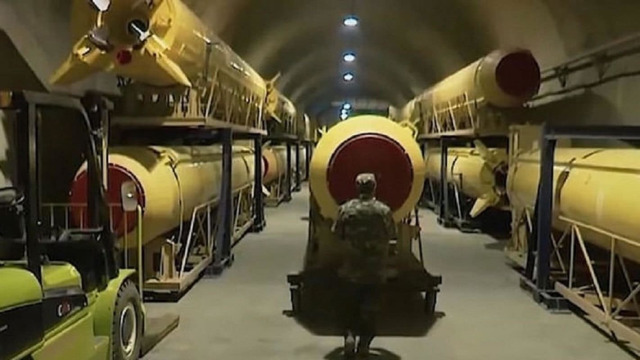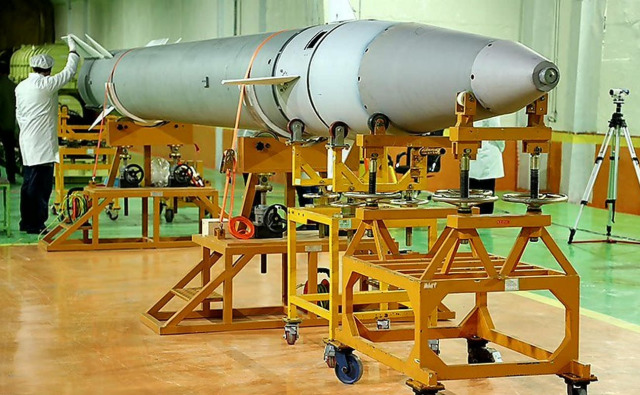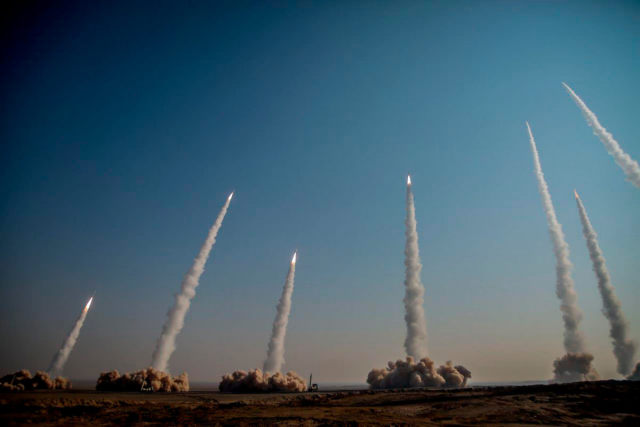We continue the topic of Iran's ballistic missiles (BR), which was started in the previous publication ( part I ) . Having briefly reviewed the history of the formation of the Iranian missile strategy, we will pay attention to the research and industrial institutions and enterprises engaged in the creation and construction of BR.
IRI ballistic missiles: the structure of the missile industry
The main developer and manufacturer of missiles of the Islamic Republic of Iran is the Aerospace Industry Organization (AerospaceIndustriesOrganisation, AIO, Tehran), which is under the direct control of the Ministry of Defense and Support of the Armed Forces of Iran (MinistryofDefenceandArmedForcesLogistics, MODAFL, hereinafter – the Ministry of Defense of Iran). According to open sources, the AIO is divided into at least six so-called industrial groups centered around specific areas of rocket science:
- Shahid Hemat Industrial Group (ShahidHematIndustrialGroup,SHIG; Hakimiye locality, Alborz Province) is developing and manufacturing liquid-fueled rockets;
- Shahid Bakeri Industrial Group (ShahidBakeriIndustrialGroup, SBIG; n.p. Hakimiye) is engaged in solid-fuel missiles;
- Shahid Ahmad Kezami Industrial Group (ShahidAhmadKazemiIndustrialGroup, SKIG; n.p. Hakimiye) is responsible for surface-to-air missiles;
- Samen Alami Industrial Group (SamenAlaemeIndustrialGroup, SAIG; Parkhin, southeast of Tehran) specializes in cruise and anti-ship missiles;
- The industrial group "Ya Mahdi" (YaMahdiIndustrialGroup, YMIG; Parkhin) is in charge of anti-tank guided missiles and, presumably, man-portable anti-aircraft missile systems;
- Shahid Mahallati Industrial Group (ShahidMahallatiIndustrialGroup, SMIG; n.p. Hakimiye) probably specializes in materials science and metallurgy issues.
Each of the listed industrial groups, in turn, is divided by industry into several divisions with more specific functions. In addition, in addition to its official subsidiaries, AIO uses a network of replacement shell companies to purchase materials, components and equipment abroad.

Underground storage of IRI ballistic missilesIn the publications of foreign sources, certain interest is aroused by the relationship between industrial groups (in particular, between the groups "Shahid Hetam" and "Shahid Bakeri") and the question whether these structures work in tandem or represent competing institutional centers.
It seems that the answer is somewhere in the middle. So, in a 2014 documentary about the Iran-Iraq war, an Iranian rocket engineer claims that the development and development of liquid and solid-fuel missiles took place in parallel. Moreover, there were no contradictions between them. "Sometimes they helped each other in the form of a competition, and sometimes they really put their capabilities and information at each other's disposal." An example of such cooperation is the basic guidance technology that the developers of liquid-propellant missiles have transferred to colleagues in solid-fuel systems. Later, as part of the solid-fuel program, the Iranian terminal guidance technology was developed for the first time, which became common property.
Another important element of the Iranian Defense Ministry's missile program is Iran Electronics Industries (IEI) and its subsidiaries, which supply various electronic components for the construction of missiles. In particular, Shiraz Electronics Industries, a subsidiary of IEI, worked on ring laser gyroscopes. At the same time, another subsidiary of Isfahan Optics Industries took part in the development of the Fateh-110 ballistic missile. IEI itself also participated in the development of high-precision guidance for the fourth generation of the Fateh BR family.
The Defense Industry Organization (DefenceIndustriesOrganisation, DIO), subordinate to the Iranian Defense Ministry, contributes to Iran's missile program. In 2021, under the auspices of DIO, a new solid-fuel propulsion system was introduced, which was called the most complex in the country. However, the exact institutional affiliation or location of the unit was not reported.
Presumably, the Defense Innovation and Research Organization (SPND), supervised by the Iranian Defense Ministry, participates in Iran's missile program, although this structure is mainly known for its connection with the past Iranian nuclear weapons program "Amad". In 2020, in an interview, the former head of the Atomic Energy Organization of Iran (AtomicEnergyOrganisationofIran), Fereydoun Abbasi-Davani, said that SPND and Mohsen Fakhrizadeh, who headed it earlier, were working on missile issues. In the same interview, he emphasized the role of computer modeling in the development of high-precision missiles, which potentially indicates the special role of SPND in this area.
In addition to the listed organizations controlled by the IRI MO, there are structures related to missiles, but under the more direct control of Iranian military formations. In particular, Western sources refer to the Organization of Jihad for Research and Self-sufficiency of the ground forces of the Iranian army (ResearchandSelf-SufficiencyJihadOrganisationoftheIranianArmyGroundForces, SSJO-A) as such. This organization has developed high-precision guidance equipment for obsolete multiple launch rocket systems (MLRS) of the Nazeat type, which are in service with the SV. In 2021, it was announced that Iran's military forces were in the process of testing a new MLRS with a firing range of up to 300 km, potentially signaling a more serious turn towards missile technology on the part of Iran's regular army.
In the mid-2000s, as a parallel structure of the Shahid Hemat Industrial Group in the direction of solid-fuel space launch vehicles, the IRGC Jihad Research and Self-Sufficiency Organization (Research & Self-SufficiencyJihadOrganisation, SSJO) began its activities. Presumably, the organization was a cover for the acquisition of technologies for the production of long-range ballistic missiles. The demonstration of the Salman upper stage engine, the launch of the Kased launch vehicle and the activities at its large facility in Shahrud show that the organization continues to function in this role. Finally, the IRGC's Al-Quds formations (Unit 340), in cooperation with the IRGC's Aerospace Forces and the country's missile industry, are leading Tehran's joint efforts to provide unguided and guided missiles and their production technologies to Iran's non-state allies abroad.

Universities are another important participant in the development of Iranian missile technologies. State universities have played a role in almost all missile projects that have received the Iranian Khorezmi Award. Among other things, the participation of "university professors from all over the country" in the development of the Sajil BR, the assistance of three universities in the development of the Simorg engine and the participation of the K. N. Tousi University of Technology (Tehran) and Sharif University of Technology (Tehran) in the development of the Iranian Fateh-110 BR. Experts note the special positions and deep penetration into the Iranian missile programs of the Malek Ashtar University of Technology (Tehran, Isfahan), subordinate to the IRI Ministry of Defense, and Imam Hossein University (Tehran), controlled by the IRGC. At the same time, Malek Ashtar University has documented the development of a process for the production of polybutadiene with hydroxyl ends, a polymer used in solid fuels.
State and private companies that do not belong to the military formations of Iran have also played a role in the development of Iranian missile technologies. Their involvement ranges from relatively minor roles, such as providing through public tenders some of the materials needed by the relevant organizations, to the construction and installation of equipment at Iranian missile sites and to more substantial cooperation. An example of the latter is the trailer manufacturer Mammut Industrial Group, which was sanctioned by the US Treasury Department for the supply of ballistic missile equipment in the interests of the Shahid Hemat industrial group, and which is probably also involved in the production of transport launchers. Introducing the new Raad-500 BR at the beginning of 2020, the commander of the IRGC AKC, Amir Ali Hajizade, mentioned the private sector, which can help in the production of an improved carbon fiber engine housing. It is obvious that in the future the private sector will begin to play a more significant role in the Iranian rocket industry.
Space. The institutional framework of the IRI space program is divided into organizations under both military and civilian control. Militarily, AIO plays an important role, developing and producing launch vehicles "Safir", "Simorg" and "Zolyanakh". SSJO undertakes its own efforts in the field of space exploration. The organization's activities include the creation of small CubeSat satellites for military intelligence, as well as the development of advanced engines for solid-fuel launch vehicles. Iran Electronics Industries, a company subordinate to the Ministry of Defense of Iran, according to documentary data, took part in the development of the first Iranian satellite Omid.
The civilian side of Iran's space program is managed by several organizations subordinate to the Ministry of Information and Communication Technologies of Iran. The Iranian Space Agency (IranianSpaceAgency, ISA), the coordinating body of Iran's civil space efforts, acts as the head structure. The Iranian Space Research Center (IranianSpaceResearchCentre, ISRC) is the main organization engaged in the development of space technologies, such as small apogee engines and satellite testing. The Institute of Aerospace Research (AerospaceResearchInstitute, ARI) has developed a series of rockets for sounding the atmosphere "Kavoshgar", as well as biocapsules for experimental launch of monkeys. He was also entrusted with the development of a manned capsule for the first suborbital flight of an Iranian into space.
As with the military missile program, public universities play an important role in the Iranian space program. Thus, the Scientific and Technological University of Iran and the Technological University of Iran participated in the creation of Iranian satellites. Amira Kabir and Sharif University.
To be continued…
Based on the materials of the resources: iiss.org, missilethreat.csis.org, iranprimer.usip.org

